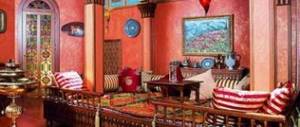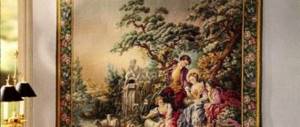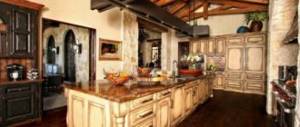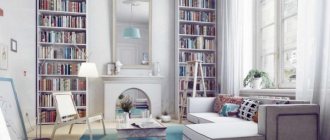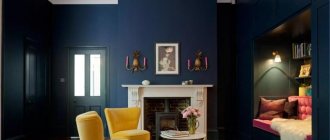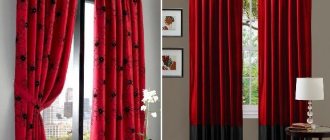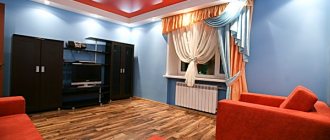Every apartment owner wants to create a cozy atmosphere in his home, but he wants to combine all this with a stylish, fashionable design. Modern decorative elements allow you to add the necessary accents to the design of any room. One such popular decorative item is the faux fireplace in the living room.
An artificial fireplace is an excellent alternative to a real fireplace, the installation of which is not always possible due to technical limitations.
A niche for a TV made of plasterboard - simple instructions with photo examples and design tips
Recently, it has become relevant to hide equipment, in particular television equipment, in the wall area, especially if the interior of the room already has options for shelves or niches.
In this article, we will look at the most common options for hiding household appliances and offer basic instructions for creating them, namely, how you can build a niche for a TV with your own hands using drywall.
Design task: how to fit equipment into the interior
Now there are a huge number of options for depicting concepts, however, on the one hand, they represent a completely unusual design, and, on the other, the process of creating them is quite complicated.
The simplest option for a plasterboard TV niche is the classic one, made using a load-bearing wall or a plasterboard surface that serves as the back wall.
There are so-called portal elements, which are a niche from the ceiling itself to the floor covering. The relevance of using this kind of structural elements lies in the implementation of numerous ideas, even in those cases where there is no smooth cladding. The final result looks quite harmonious and worthy.
Such a portal is mainly framed by two rather wide columns. The form option is selected taking into account the customer’s wishes, without in any way affecting its functional use.
The most complex shapes include curved versions of the front or side parts. Such a structure may well be complemented by additional shelf options used to accommodate a home theater and other equipment.
More detailed options can be seen in the photo of the niche for the TV.
Watch the video: How to make a niche for a TV from plasterboard
A very original living room with panoramic windows - firstly, huge windows let a lot of light and air into the room, and secondly, dark shades of wood throughout, but they don’t look heavy due to such a luxurious window. Our apartments often have smaller windows by an order of magnitude, so you should pay attention to lighter interiors - or balance this with a large amount of light with the help of chandeliers, lamps - table, floor.
False fireplace: types and principle of operation
A false fireplace is a design whose design completely or partially replicates the appearance of a conventional fireplace. But since the design is only an imitation of a real fireplace, it does not have a chimney.
But this does not mean at all that the false fireplace is just a shell, which is just a decoration that does not fulfill its main purpose. Most people build a fireplace to enjoy the sight of flames. It is clear that in a city apartment and, moreover, without an appropriate chimney exhaust, it is simply unsafe to burn wood. However, you can reproduce the appearance of a burning flame in other ways.
- for example, the portal of a false fireplace can be decorated with ordinary firewood and furnished with tall candles. When the candles burn, it will seem as if the fire is coming from wood;
- You can also use a bio-fireplace for this purpose, which almost completely replicates the appearance of a burning hearth;
- In addition, there is an interesting device that is ideal for a false fireplace. Such a device is an electronic photo frame. Having selected the required mode, the liquid crystal display of the photo frame will glow with flames, which will create the complete illusion of real fire.
False fireplace photo
False brick fireplace
False fireplace in a modern interior photo
Photo of false fireplaces in the living room
The choice of the operating principle of a false fireplace directly depends on the features of its design. It is customary to distinguish three types of fireplace imitations:
- reliable;
- conditional;
- symbolic.
Reliable false fireplaces differ from their older brothers only in the absence of a chimney. All other parameters of this design (size, height, depth of the firebox, etc.) exactly replicate a real fireplace. The frame for a reliable false fireplace is most often made of plasterboard, the surface of which can be additionally plastered, covered with wallpaper or decorated with other materials - wooden panels, pebbles, marble chips, etc. If you intend to make a false fireplace of this type with your own hands, keep in mind that the depth of its firebox must be at least 40cm. You can reproduce the appearance of a burning fire in an authentic false fireplace using all of the above methods: candles, a bioburner, or using an electronic photo frame.
The use of a false fireplace as interior decoration
Beautiful false fireplaces photos
False fireplace to the wall photo
False fireplace in the niche under the TV
The easiest way to create conventional false fireplaces is if the room initially has a niche up to 20cm deep. Fireplace imitations of this type are distinguished by the presence of a portal, which are wall niches. The frame of a conventional false fireplace can be made of anything: plasterboard, polystyrene foam, polyurethane, wood, etc. In this case, the easiest way to indicate the type of burning flame is with the help of candles, a photo frame of the appropriate size, or backlight. To make the firebox of a conventional false fireplace seem larger, the walls of the niche can be decorated with mirror tiles.
Brick false fireplace
Decorative false fireplace
False fireplace design
The symbolic false fireplace has the most unusual design. Unlike previous options, the task of this design is to externally imitate a fireplace, without performing its function. Simply put, this is just an abstract imitation of a real design. To make a symbolic false fireplace, you can use almost any materials - brick, stone, wood, drywall, etc. Symbolic designs, as a rule, do not correspond to real fireplaces either in size or shape. Some designers use interior stickers or simply draw it on the wall to create the appearance of a fireplace. If the design allows you to indicate fire, it is better to use decorative candles or lighting for this purpose.
False fireplace made of plasterboard photo
A false fireplace built into the wall as an interior decoration
Decorative false fireplace with firewood in the living room interior
Luxurious false fireplace
False fireplaces in the living room interior photo
Mounting and load from the TV
Recently, equipment has become much more compact compared to previous versions, but despite this, it occupies quite a significant place. Its dimensions must be mentioned when creating the main frame of the niche for more reliable fastening.
Basically, TVs are installed using hanging mounts at a level of a meter from the floor covering. This gives the piece of furniture a certain lightness and calmness.
Fixing the TV panel on a plasterboard wall is subject to certain requirements:
- reinforcement of the rear part - selected taking into account the weight category of the installed equipment;
- The bracket is fastened strictly according to the instructions - for reliability it is better to use four fastening points;
As fasteners, it is better to use metal dowels in the form of an umbrella and a Hartmut fastener. If there is a wall made of brick or concrete, it is recommended to use bolted or chemical anchor options.
Direct assembly of the main frame
When compared with other furniture options, the TV niche has a separate assembly structure. The only similarity is that it has a main element and additional details of a special figure that have a formative function.
For non-standard shape options, a special so-called bent profile is best suited, which can create a suitable bend of the desired shape.
The assembly process itself is carried out as follows:
1. Installation of guide profiles. The most advantageous option for optimal load is 50 mm.
2. Approximately 4 rows of guides are nailed to the rough version of the plane, and in the case of continuous sheathing - to hidden plasterboard profiles.
3. An ordinary small podium is mounted at the foot.
4. If there are side columns, it is recommended to duplicate the guides, between which it is necessary to insert special jumpers of the required length; they will be the ones who will determine the depth of the excavation.
There are several profile connection options:
- with the help of bent wings”;
- use of “crab”;
- using a special insert that serves as a possible profile extension;
- The best option is cutters.
One more point should be taken into account: before sewing the frame, it is recommended to lay all the wires in the internal plane of the structure.
The final stage: cladding and finishing
The process is not a special technology. For the curved version, the drywall must be soaked.
As for corner parts and connections, the requirements in this case are quite strict. To finish the interior you will need paint that has an antistatic effect. It is better to cover horizontal shelves with a thin version of glass of the required size.
Photo: built-in fireplaces in a wall niche
We can safely say that built-in fireplaces can satisfy the wildest wishes and will complement the interior of the room with real fire. A variety of options will complement the room regardless of size and style. Technological innovations allow everyone to feel real warmth and comfort in their home. And the use of modern control panels and automation allows you to automate the entire process of operation of the device, leaving the user only pleasure from work.
Watch a video of an amazing bio-fireplace Berlin
“False fireplaces in the interior: the art of imitation”
Decorative false fireplaces in the interior can never be a substitute for real ones, but this does not deny that they have many advantages. What is this - a tribute to short-term fashion or a legitimate accessory?
Who needs a false fireplace?
Making a false fireplace
- Stone
- Drywall
- Tree
We design the firebox window
- Candles
- Books
- Drawing
- Vintage style
“Who needs a false fireplace?”
- To the townspeople. The construction of wood-burning fireplaces in most city houses is not possible. Electric fireplaces and gas fireplaces in the interior are quite expensive; students and young families cannot always afford them. Or maybe you are not one of those who will sit by the fire for a long time, you lead a dynamic lifestyle, and the fireplace interests you only as a highlight for the interior.
- Space innovators. A false fireplace is very convenient to use to camouflage the shortcomings of a room.
- To parents. The safety of a false fireplace allows you to make it a play element in a child’s room or an accessory for a little fashionista’s teenage room.
- Those who like to follow trends. False fireplaces in the interior, as in the photo, are now in fashion, as they bring an elegant touch to boring apartments that have been stripped of decor. They are like an elegant chandelier or a dressing table - things that go out of everyday life, but can turn everyday life into holidays.
A false fireplace lacks the main attribute of a real wood-burning fireplace - the firebox. Therefore, purchasing the first one is simply purchasing a separate fireplace portal. But the art of fitting it into the interior also needs to be learned, which is what we will do immediately!
How to heat a bio-fireplace?
The process of obtaining biological fuel for modern biofireplaces
Of course, every future owner is interested in the question of what fuel can be used and how to choose it correctly? It’s worth starting with the fact that biofuel is absolutely safe and does not emit any harmful substances during operation. High-quality fuel does not create strong odors during combustion (burning, waste materials, etc.), and the CO2 content is also not harmful to health.
The only thing is that after you have used the device for some time, you need to ventilate the room to remove the carbon dioxide released.
As a rule, the fuel that comes with the device is of high quality. However, alternative options are permitted. In turn, the use of uncertified fuel can shorten the service life of the fireplace. These fuel savings only increase overall costs. Buyers of devices should understand that the manufacturer is obliged to provide instructions and recommendations on what flammable liquid is permissible to use, how to care for the bio-fireplace, etc. Find out all the pros and cons on a separate article on our website: biofuel for a fireplace.
“Making a false fireplace”
In the future, electric fireplaces can take the place of false fireplaces. If you allow this option in the future, calculate the depth of the firebox in advance - it should be quite spacious. There are several ways to build an artificial fireplace in the living room interior. If you decide to do it yourself, choose materials that you can handle.
"Stone"
The first way is to build a fireplace yourself from bricks or stone. This false fireplace is suitable for a country, rustic or Russian country interior, as in the photo. The rougher the stone, the more your fireplace will look like a real antique one, and not every guest will notice the difference at first glance. If your kitchen or dining room lacks coziness, do not rush to install expensive bio-fireplaces in the interior, start small. If you wish, you will always have time to occupy the niche of a false fireplace.
“Drywall”
Study the Internet, where there are many diagrams and drawings; anyone can cut out a fireplace portal from plasterboard. The main advantage of the material is its flexibility and readiness to change. It can be painted, aged, pasted on with classic stucco or plastered.
"Tree"
A false wooden fireplace will be a good addition to your existing set if you need to occupy an empty corner. This material is suitable for decorating good old English and oriental interiors.
Arrangement of a false fireplace
To place a false fireplace in the interior, you first need to decide on the purpose of its installation , think through the layout of the room, etc. After all, a false fireplace should decorate the room, make it more comfortable, “homey,” and not create pretentiousness and bad taste. If the fireplace needs to hide some flaws in the room, carefully measure and calculate the entire area where you plan to install it. Perhaps in the future you will want to install an expensive electric fireplace in its place - then you should carefully calculate the depth of the firebox so that it is spacious enough to install an electrical system there.
There are several options for installing a false fireplace at home:
- Buy a ready-made stone or marble portal. Of course, it costs a lot, but the result will exceed all expectations. The modern market offers a huge selection of ready-made models that are suitable for any interior - low, high, straight, corner, non-standard and much more. But it is worth remembering that ready-made portals for fireplaces are usually designed for use with a firebox, so some design modifications and improvements may be required on your part.
- Buy a ready-made polyurethane portal for the fireplace. A fairly popular option today, primarily because of its low price, however, the choice of models of such portals is not very large. They play only a decorative role and are not designed for further embedding of the firebox, but they can be painted at your discretion, and if desired, increase the depth of the portal using a plasterboard box.
- Do it yourself. And it’s not so difficult; detailed photos and video master classes will be an excellent assistant even for a novice master.
Beautiful options for false fireplaces
Materials for a false fireplace
If you decide to make a false fireplace yourself, choose materials that you are most comfortable working with and that you know. You can make such fireplaces from almost any available means , having a bit of imagination:
- From stone . You can lay out a fireplace made of stone or brick in a rustic style or a country version (photo). Moreover, the rougher the stone, the more natural and ancient your fireplace will look; not every guest will be able to feel the difference. Another option is to install the base of the portal from a material that is easier to work with and make the cladding with stone. However, here it is worth considering the base material - if it is plasterboard, then the facing material should not weigh down the structure - here it would be best to use artificial stone.
- Tree . You can create a magnificent fireplace made of wood, which will be an excellent addition and continuation of the furniture set, creating a classic English style in the interior.
- Drywall . Probably the most popular material today for self-installation of a false fireplace. This is mainly due to the low cost and ease of working with the material, which allows you to create a wide variety of design options both in skilled hands and by an amateur. Today on the Internet there is a huge number of drawings and diagrams with detailed photos of the work, allowing you to make the installation process as easy as possible.
“Designing a firebox window”
How to fill the portal window of a false fireplace for an apartment is up to you to decide. Sometimes it is appropriate to leave it empty or stick a strip of patterned wallpaper on the back; this option is perfect for modern youth interiors. If you need fresh ideas, read on!
"Candles"
You can get closer to the aesthetics of a real fireplace and place a live fire inside. To do this you will need a set of large candles, as in the illustration below.
More candles - a livelier effect! Look how interesting the large-scale composition looks, worthy competition for the TV.
“Books”
Using a fireplace as a bookshelf is a classic, but not everyone can afford to organize a library in a portal! All that remains is to decorate such a fireplace with the inscription: “Manuscripts do not burn!”
"Drawing"
An excellent option for those who feel a creative streak in themselves is a slate board in place of the firebox. It can be used as a banal board for notes or sketches, or to sketch firewood and coal. Remember that thought is material - perhaps this will be an excellent visualization of your dream of a real fireplace.
"Vintage style"
Don’t know how to beautifully arrange a grandfather clock, an antique vase or antique traveling bags in your interior? Imagine that a false fireplace is an elegant frame that will decorate whatever you put into it. Actually, that’s what the owners of the interior in the illustration below did, and it turned out great.
Did you like all the presented options, but you still can’t choose the best one? Fill the portal of a fake fireplace with all sorts of things, as in the illustration below, even such an unusual design can turn out to be unexpectedly stylish. Of course, not least because of the unconventional color of the portal, which itself invites you to play with the decor.
Plasterboard fireplace
The fireplace portal made of plasterboard is decorated with glass and an electric fireplace. The portal with an aquarium looks original and stylish. It can also be placed on a wide shelf.
An electric fireplace made in the wall looks unusual and completely merges with the surface. Designers recommend decorating an empty portal with a forged grille, firewood, candles, original vases, a painting, a mirror. Another step-by-step method for constructing a false fireplace. To build it you will need plasterboard, guide rack profiles (for the frame), self-tapping screws with a hidden head (fixing sheets), ordinary self-tapping screws (from 1.4 to 1.6 cm), dowel nails (attaching profiles to the wall and floor), primer , putty, glue, grout. Layout is done according to the drawing, taking into account the dimensions of the future fireplace.
With its help, calculations and expenses for materials are made. Make models from foam plastic or cardboard. When creating a layout, it is not necessary to adhere to exact calculations. It is needed in order to have a visual idea of the design to be made. The layout can indicate errors, it is easy to move it around the apartment and experiment (choose color, decor).
After making the frame, it should be sheathed with gypsum board. For these purposes, you will need to cut the sheets with a manual grinder. The joints must be additionally secured with a profile (take this into account when purchasing materials). The seams of the sheathing are secured with self-tapping screws and puttied. Often plasterboard material does not require finishing treatment, so after some time the lining of the portal can be changed without disassembling the device.
Plasterboard structures are the most popular today. This material is most often used for frame cladding. It goes well with any finish and is easy to assemble. Using plasterboard it is easy to create a spatial form of any complexity.
The price of the material is low.
Materials for making false fireplaces for the living room
Depending on the raw materials used in the manufacture of this design, its cost also changes. One material is accessible and inexpensive, but not of high quality in operation, the other is expensive, durable, natural. It is worth considering the characteristics of each.
It’s easy to make an imitation of a fireplace portal with your own hands using available materials
Drywall
This material is very convenient for decorating a frame of any shape. It won’t be difficult to make a corner or straight version of this decor out of it. Beautiful appearance, the ability to combine with finishing, ease of assembly, low weight, low cost - these are its advantages.
Drywall allows you to make a box of absolutely any configuration
A plasterboard portal can be painted, lined with stone or tiles, and decorated with shaped elements
Cons: possibility of mechanical or thermal damage, short-lived service.
Natural wood
Materials of artificial origin are more affordable than natural ones. But the latter have excellent performance characteristics and a beautiful aesthetic appearance.
A wooden false fireplace with rounded shapes is a suitable option for a living room in the Art Nouveau style
And others
Stone products are heavy, difficult to assemble, and expensive for materials and installation. Its advantages include durability, original and antique appearance. Used for ethnic style.
For connoisseurs of antiquity, a fireplace made of natural or artificial stone would be ideal.
Ceramics is a fairly fragile material to mechanical stress. Rarely used. It has a beautiful appearance and an expensive price.
Decorative fireplace for a cozy atmosphere
There are a lot of options for creating a pseudo-fireplace in the interior of a wide variety of rooms. You can use the services of specialists or try your hand at creating a fireplace from the following materials: To decorate a decorative fireplace, which is created using a frame and plywood or plasterboard sheathing, the following materials are used: On such a pseudo-fireplace, created using a wooden frame covered with plasterboard, it turns out quite durable fireplace mantel. It is quite capable of supporting the weight of photo frames, books and even vases of flowers.
In a word, a false fireplace is not only a decorative element itself, but also helps to introduce other functional and useful decor into the interior of the room. A mobile pseudo-fireplace is most often a structure similar to a cabinet, but with a facade in the form of a fireplace portal. Such a piece of furniture is, of course, very convenient - it not only decorates the design of the room, adds a special aura, it can be moved, taken with you when moving and used as a storage system, while it is not easy to install books or framed photos on the mantelpiece, but and store necessary things inside the structure.
- drywall;
- tree;
- tile;
- natural or artificial stone;
- wall panels;
- polycarbonate;
- metal;
- ordinary cardboard and film;
- even art and wall stickers.
Classification of devices by location
It is customary to distinguish several main classes among built-in biofireplaces:
- Floor products
. As a rule, these are stationary systems that are installed on the base of the floor, without preliminary preparation of the surface; - Wall fireplaces
. They are used as an element of interior design, they allow you to imitate almost any finishing material, and therefore fit perfectly into the room. They are not used as a source of heating and serve only a decorative role; - Desktop options
. They are the smallest. However, this is the most compact and convenient solution, which emits a significant amount of heat and creates a special atmosphere in the room; - Street options
. They are part of gazebos, terraces and other objects that are located on a personal plot; - Interior elements
. Such products are skillfully selected as design elements in complex layouts and can last for many years without maintenance; - Angular
_ Used for installation in walls and maintaining a fire over a large area. Such options are most often installed in country houses and cottages. Its significant size allows you to sit comfortably near the fireplace and stay warm.
Options for a built-in bio-fireplace in the wall can be divided into two types:
Biofireplace with automatic flame adjustment
- Manual.
Such products require regular refueling and allow you to remember the old traditions of starting a fire; - Automatic.
Allows you to perform all functions automatically. All procedures for ignition and operation of the device are transferred to the devices, the user will only have to enjoy the warmth.
It is worth saying that the operation of both devices provides the ability to ignite and extinguish a fire.
DIY plasterboard fireplace: step-by-step manufacturing instructions
Island fireplaces are quite voluminous structures. Their construction requires experience and knowledge of building structures. The consumption of materials for this model is the highest, since the portal is designed on four sides. The room for them should be spacious. The portal should not be placed in an area of active traffic.
Elements with sharp corners can cause bruises, especially in families with children. Choosing the model and finish of a plasterboard fireplace is a very responsible task. The fireplace should become the central accent of the living room interior. Which style to choose, where to place it - ideas will suggest spectacular and stylish design solutions. Limestone finishing or brickwork will harmoniously fit into the interior of a country estate in a rural style or chalet.
The external heaviness of the structure will give solidity and natural expressiveness. This material goes well with wood and simple plastered walls. The design of the premises in Scandinavian, English, Mediterranean style, as well as loft-style decoration, will be complemented by an accent in the form of a fireplace trimmed with stone.
To build a box around an existing chimney, it is better to invite a specialist. A number of conditions must be observed to insulate materials from high temperatures and ensure safe operation of the structure. The chimney pipe itself must be insulated with mineral wool and air gaps between the structural elements must be maintained. The reward will be a structure that will add solidity to the interior. The suspended ceiling flows structurally into a protruding plasterboard panel.
A rectangular niche is made in the panel for a decorative firebox. The firebox has a flat frame that can be painted to match the color of the panel or highlighted with contrasting colors. It is better to repeat these colors in the decor of the room.
For a fireplace, it is enough to add one or two original details to destroy classical stereotypes, move the fireplace frame at an angle to another - and futuristic features of the high-tech style will appear.
- First you need to choose the room where the fireplace will be installed.
- Then you should decide on a specific place in the room.
- If the scale of the room allows, the fireplace can be placed against a longitudinal wall. Preferably in the middle, which will make it possible to decorate it with a false chimney and decor.
- In a room with a small area you can always install a corner fireplace.
- However, one way or another, the selection of location should be carried out taking into account the technical requirements of the room.
An important element of the decor of any fireplace is the portal. Essentially, this is the façade of the entire structure, which will be visible. It can be made with almost any material. Most often used for these purposes:
Self-installation of a false fireplace
Installing a false plasterboard fireplace in a living room or other room today is the simplest option that even a novice craftsman can handle with a minimal set of tools for the job. All you need are sheets of drywall (even leftovers from repair work are suitable, since the material consumption is small), profiles, building level, self-tapping screws with dowels, a tape measure and a screwdriver.
The basis for such a portal will be a box made of plasterboard on profiles, which after installation can be decorated with polyurethane, gypsum stucco, marble or other stone, both natural and artificial, or simply painted. It can be made of any configuration and size, which will easily fit even into the most complex interior.
Before starting work, choose the location of the future structure , measure everything carefully so that there are no unpleasant surprises later, draw a plan of what the fireplace will look like in your interior to understand how harmoniously it fits.
After completing all the necessary measurements, it is advisable to draw basic drawings, taking into account the scale of the room and the future false fireplace. It differs from the plan in that it contains not only the appearance of the future product, but also a complete diagram of the structure, its fastenings and frame.
Work order
- Initially, markings are made based on the working drawing. Markings are made both on sheets of drywall and on the walls and floor, thus outlining the location of the future location of the structure.
- Using a screwdriver using UD self-tapping screws, the profile is attached to the floor, starting from a plank parallel to the wall. Next, the side profiles are attached between the main one and the wall. The fastening step with self-tapping screws is not very frequent - about 25–30 cm.
- After this, the wall profiles are screwed according to the markings, after which they are removed and dowels are screwed into the finished holes. This is done to ensure uniform installation of dowels over the entire area.
- The next stage after screwing in the dowels is the installation of UD profiles with a screwdriver. During the work, constantly check with a tape measure and level the accuracy of the markings on the surface of the floor and walls according to your drawing.
- After installing the frame of 6 main profiles, we proceed to cutting the drywall using a utility knife or other improvised means. First, cut through the drywall approximately to its middle, after which the sheet is placed on a flat surface and carefully folded. The cut is thus very even and the remaining layer is cut with a knife.
- To create a durable structure, we also connect the base with CD profiles . The front part of the fireplace is attached to the floor using profiles that are screwed to its back side in advance, after which all other parts are assembled at the very end of the sidewall.
- Puttying and grouting corners is the last stage in the construction of a plasterboard structure.
Finishing
After installing the structure, it’s time for finishing, where the only limitation will be your imagination, allowing you to create any interesting design for a living room or other room using a false fireplace (photo). It can be painted, covered with various materials, plaster stucco molding, mosaics and any other decorative materials that are so rich in the construction market today can be added.
There are also many options for decorating the inside of the fireplace. For example, if you line it with mirrors and put candles inside, you will create the effect of a living fire, which will look great in a living room with any style. But do not forget to treat the top of the niche with heat-resistant materials.
You can also place glass at the base of the fireplace, which will visually increase the space, or make a shelf from solid wood and place books, candles, other interesting design objects there, or beautifully lay out logs.
Examples of false fireplaces

